Plant viruses – identify and prevent
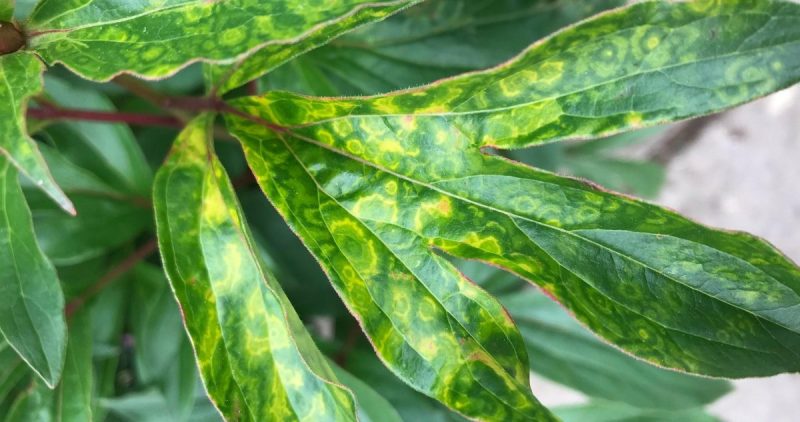
Virus diseases are diseases caused by plant pathogenic viruses. The first virus to be discovered was the Tobacco Mosaic Virus (T.M.V). Although some plant diseases are known today as viroids were reported long before the pathogen was discovered. There are currently about 500 known virus diseases worldwide, which attack different plant species.
APPLE MOSAIC VIRUS
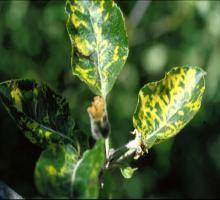
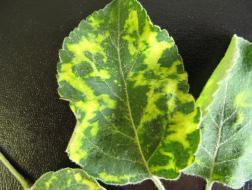
The virus has been detected in many varieties of apples as well as in vegetative rootstocks. Apart from apples, other species (peach, plum, etc.) are also parasitized.
Symptom. The disease occurs mainly on the leaves. Symptoms and effects of the attack vary considerably depending on the plant variety, virus strain and environmental conditions. Irregularly shaped spots of different sizes appear on infected leaves, spread unevenly over the surface of the leaf blade. The spots may have different colours (light green, yellow, cream or almost white). Symptoms are severe at temperatures of 18-22º C and are masked at over 26º C. Leaves attacked prematurely, leading to the weakening of trees, especially young ones.
Transmission and spread of the virus occur through grafting, planting, propagation and trade in infected plant material.
Prophylaxis. Prevention methods include the use of healthy grafts and rootstocks, phytosanitary control in nurseries when symptoms are visible, removal of infected trees.
PLUM POX VIRUS
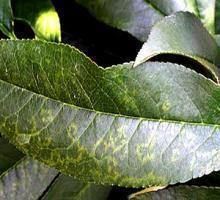
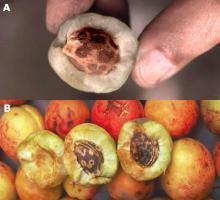
It is considered as one of the most dangerous diseases of plum both by the damage it causes and especially by the large extension it has in European countries.
The attack occurs on the leaves and fruit of plum trees of susceptible varieties.
On fully developed leaves, dark green or yellowish, circular or semicircular spots appear on the entire surface of the leaf. Symptoms may be visible in May-June and September-October, while in the hot summer months they become masked, sometimes only the shaded leaves of the tree are visible. 3-4 weeks before ripening, circular or elongated, yellowish-green, watery spots appear on the surface of susceptible fruit. The fruit’s mesocarp is reddish or purplish and has a rubbery consistency.
This virus also attacks other fruit trees, including peach, apricot, blackberry and crocus.
Transmission of the virus is by infected material and spread by aphids and leafhoppers.
Prophylaxis. As prevention measures it is recommended to use healthy rootstocks and grafts, planting healthy seedlings, growing resistant varieties, chemical control of insect vectors.
As a control measure, thermotherapy is recommended – keeping young seedlings for 2-3 weeks at 37ºC, followed by grafting the tops on healthy rootstocks.
GRAPEVINE FANLEAF VIRUS
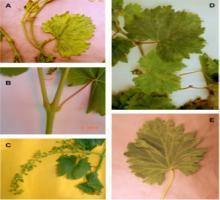
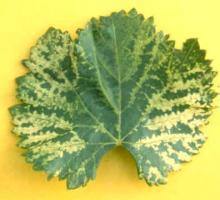
The virus causes damage to vines, reaching 20%.
Symptom. The disease appears on all plant organs. Thus, the growth and development of the root system are reduced and the grafting capacity is reduced. The stems of the attacked seedlings are poorly developed, with internodes of different lengths, often arranged in a zigzag pattern. Sometimes the nodes are very close together. The secondary shoots are more abundant, giving the plants a bushy appearance, and the leaves are crowded, the cords have double nodes. Oily rings or spots appear on the leaves of infected stumps, giving a mosaic appearance.
Also, the leaves on the attacked stumps are smaller, with deformed, asymmetrical, often fan-shaped leaf blades. The leaves have abnormal denervation and irregular denticulation, with elongated and very sharp edges. Other characteristic symptoms of the disease are that the stumps bloom weakly, the flowers do not bind and rot, reducing the number and size of grapes.
It is spread by grafting grapevines, by trade-in infected plant material and by nematodes.
Prophylaxis. As preventive measures, it is recommended to plant on land that has not been cultivated in the last 3-5 years with vines or treated against nematode vectors. Healthy material should be used for planting.
TOBACCO MOSAIC VIRUS
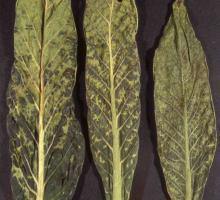
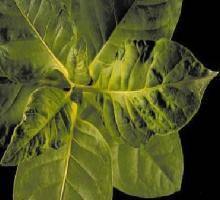
The virus that causes this disease is common in all countries, causing significant damage to many crops.
Symptom. In tobacco, the typical symptoms of the disease appear on the leaves. Nerves of young leaves become slightly chlorotic. Later on developed leaves, irregular, open-green or yellowish spots appear, alternating with the green regions to give the leaves a patchy appearance. Affected leaves are deformed and rough.
In addition to tobacco, this virus attacks tomatoes and peppers. From one year to the next, the virus is transmitted through seed and soil, and during vegetation, it spreads through mechanical contact between healthy and diseased plants and through tools.
Prophylaxis. It is recommended to disinfect agricultural tools and to remove from the crop any specimens showing symptoms of the disease. Crop rotation is also recommended and the safest measure is to grow resistant varieties.
TOMATO MOSAIC – TOBACCO MOSAIC VIRUS IN TOMATO
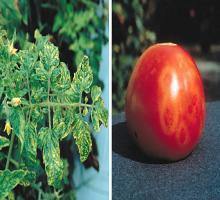
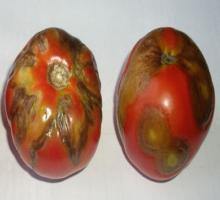
It is the most common tomato virus. The attack is found in field crops, greenhouses and solariums, leading to a loss of quality and quantity.
Symptom. The disease occurs through different symptoms, depending on the strain of the virus, the plants’ variety, the phase of vegetation and last but not least the environmental conditions. The forms of attack that can be encountered are common mosaic, strict, distortion (deformity) of tomatoes and fruit browning on the interior.
Common mosaic occurs the most in tomatoes grown in greenhouses and fields. Plants affected by this type of mosaic often remain smaller (have slowed growth) and show mosaic leaf symptoms (diffuse yellow-green spots alternating with normal green tissue).
The leaf blade of parasitic plants is slightly curled, shrunken, more or less irregular in shape. Tomato scab is a common and particularly serious form of the disease. It appears on stems, leaves, petioles and fruit. Brown, deepened stripes appear on stems and petioles, and on leaves and fruit, the stripes are circular or irregular.
As a result of the attack, leaves, stems and fruit are severely deformed, thus compromising the harvest.
Tomato distortion occurs on young leaves and is characterized by obvious deformation of the leaflets. Fruits of parasitized plants do not show symptoms on the outside, but when sectioned show browning of the pulp. It is seed-borne in tomatoes, transmitted through the plant debris of infected plants.
It is characterized by high resistance to dryness, being able to maintain its infective capacity in infected leaves for more than 20 years. The virus also resists the dust deposited on the scaffolding and greenhouse installations.
It can be transmitted to tomatoes from other intermediate host plants (tobacco, peppers, etc.). During the growing season, it is spread by mechanical contact between plants, by workers’ clothes and hands, by work tools.
Prophylaxis. Preventive measures include cultivation of resistant tomato varieties and hybrids, thermal disinfection of soil in greenhouses and nurseries, disinfection of tools, harvesting tomato seeds only from healthy plants, removal of suspected infected seedlings before planting.
POTATO VIRUS X
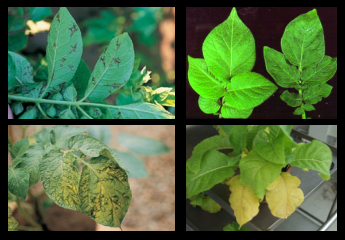
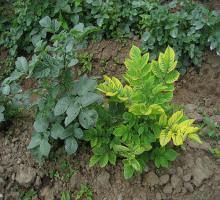
The disease is widespread in all potato-growing areas.
Symptom. The disease occurs through different symptoms depending on the potato variety grown, the strain of the virus and the evolution of climatic conditions. Typical disease symptoms appear on leaves, aboveground stems and tubers. The attack on the leaves may appear as a simple mosaic (yellowish-green spots alternating with the normal green of the leaf), up to deformation and curling of the leaves and the appearance of blackish-brown necrotic spots and stripes.
The same necrotic spots and stripes may also appear on petioles and aboveground stems. Mosaic symptoms are well evident during the flowering period and then become less obvious as the temperature rises. Varieties can be recognized only by serological tests. The attack can also occur on tubers and consists of a reduction in their size and weight.
Transmission of the virus from one year to the next is through infected tubers and spread during vegetation is through mechanical contact between healthy and diseased plants, through the hands and clothes of workers, through machinery and animals passing through the crop.
Virus X is not spread by aphids.
Prophylaxis. As preventive measures, it is recommended to grow resistant potato varieties, to use non-infected tubers for planting, to eliminate virus-infected plants from seed crops and to avoid plant injury.
POTATO VIRUS Y
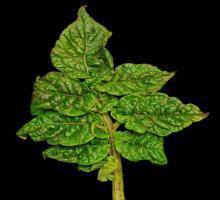
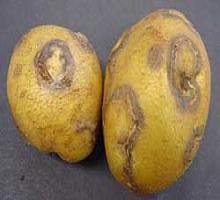
A serious disease that can reduce tuber yield by up to 80% in attacked plants.
Symptom. The reaction of potato plants to virus Y infection is different depending on the virus strain, the potato variety, climatic conditions and the presence of other viruses. The disease occurs on above-ground stems and leaves. Streaks, stripes and necrotic spots appear on the attacked organs. Leaves wither, dry out, starting with those at the base of the plant, and fall off so that the plant is left with a tuft of green leaves at the top.
As a result of the attack, plants from infected tubers and those with early infections do not yield, while later infected plants (in which the disease occurs only as a mosaic) produce virus-carrying tubers.
Transmission of the virus from one year to the next is through infected tubers and spread during vegetation is through aphids.
Prophylaxis. Preventive measures include the cultivation of resistant varieties, planting of non-infected tubers, application of agro-technical measures to accelerate vegetation (pre-harvesting of tubers, early planting), early removal of infected plants, control of vector insects and early harvesting.
Recommended products
-
You can find products on a different store
Change Store -
You can find products on a different store
Change Store -
You can find products on a different store
Change Store -
You can find products on a different store
Change Store -
You can find products on a different store
Change Store -
You can find products on a different store
Change Store -
You can find products on a different store
Change Store -
You can find products on a different store
Change Store -
You can find products on a different store
Change Store -
You can find products on a different store
Change Store -
You can find products on a different store
Change Store -
You can find products on a different store
Change Store -
You can find products on a different store
Change Store -
You can find products on a different store
Change Store -
You can find products on a different store
Change Store -
You can find products on a different store
Change Store -
You can find products on a different store
Change Store -
You can find products on a different store
Change Store -
You can find products on a different store
Change Store -
You can find products on a different store
Change Store -
You can find products on a different store
Change Store -
You can find products on a different store
Change Store -
You can find products on a different store
Change Store -
You can find products on a different store
Change Store
POTATO LEAF ROLL
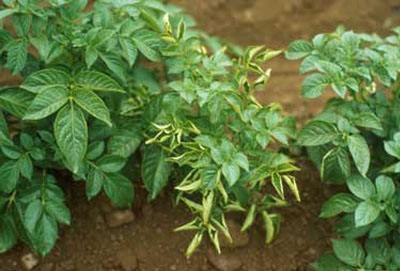
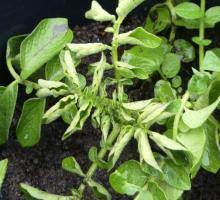
It is the most serious potato virus. Yield losses can range from 10% in tolerant varieties to 95% in susceptible ones.
Symptom. Plants from infected tubers are shorter than normal in height, with leaves with the leaflets curled towards the upper side, which become rough, hairy, brittle and stiff, with petioles in a vertical position.
Plants that are diseased, to the touch, produce a metallic noise, and in some varieties, a purplish discolouration can be seen on the underside of the leaves. As a result of the attack, the tubers remain small, few in number and with reticular necrosis.
In plants infected during vegetative growth, leaflet twisting occurs only on the upper leaves.
Transmission of the virus from one year to the next is through infected tubers and spread during the growing season through aphids.
Prophylaxis. Preventive measures include the use of resistant or virus-free planting material, removal of virus-infected plants from the crop and control of aphids.
Recommended products
-
You can find products on a different store
Change Store -
You can find products on a different store
Change Store -
You can find products on a different store
Change Store -
You can find products on a different store
Change Store -
You can find products on a different store
Change Store -
You can find products on a different store
Change Store -
You can find products on a different store
Change Store -
You can find products on a different store
Change Store -
You can find products on a different store
Change Store -
You can find products on a different store
Change Store -
You can find products on a different store
Change Store -
You can find products on a different store
Change Store -
You can find products on a different store
Change Store -
You can find products on a different store
Change Store -
You can find products on a different store
Change Store -
You can find products on a different store
Change Store -
You can find products on a different store
Change Store -
You can find products on a different store
Change Store -
You can find products on a different store
Change Store -
You can find products on a different store
Change Store -
You can find products on a different store
Change Store -
You can find products on a different store
Change Store -
You can find products on a different store
Change Store -
You can find products on a different store
Change Store
ONION YELLOW DWARF VIRUS
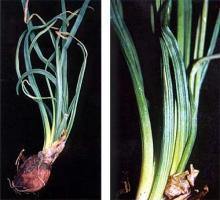
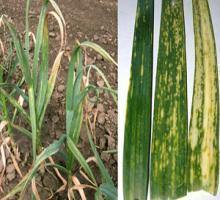
Onion mosaic or yellow streak is the most important onion viroid. It is characteristic of temperate climates.
Symptom. On the leaves and flowering stems, there are yellowish streaks starting from the base and from place to place “finger-like” shallows. In case of a strong attack, the leaves lose their rigidity and fall. Flowering stems from infected bulbs are shorter, more strongly deformed, twisted and curved downwards.
The inflorescences of parasitized plants are smaller in size, with a reduced number of fertile flowers and as a result, the seed production decreases and its germination is strongly affected. Bulbs of diseased plants are small, rot in large numbers during storage and sprout earlier than healthy ones.
This virus resists from one year to the next in bulbs and seeds of cultivated and wild Allium species. During vegetation, it is carried by aphids.
Prophylaxis. As preventive measures, it is recommended to use unharvested hard bulbs for seed crops, to plant crops on non-infested land and to isolate seed and chives plots at a distance of at least 500 m, both from each other and from plots intended for consumption, to eradicate spontaneous hosts and to grow resistant varieties.
Seed crops will be treated to control aphid vectors.
Recommended products
-
You can find products on a different store
Change Store -
You can find products on a different store
Change Store -
You can find products on a different store
Change Store -
You can find products on a different store
Change Store -
You can find products on a different store
Change Store -
You can find products on a different store
Change Store -
You can find products on a different store
Change Store -
You can find products on a different store
Change Store -
You can find products on a different store
Change Store -
You can find products on a different store
Change Store -
You can find products on a different store
Change Store -
You can find products on a different store
Change Store -
You can find products on a different store
Change Store -
You can find products on a different store
Change Store -
You can find products on a different store
Change Store -
You can find products on a different store
Change Store -
You can find products on a different store
Change Store -
You can find products on a different store
Change Store -
You can find products on a different store
Change Store -
You can find products on a different store
Change Store -
You can find products on a different store
Change Store -
You can find products on a different store
Change Store -
You can find products on a different store
Change Store -
You can find products on a different store
Change Store
TULIP BREAKING VIRUS
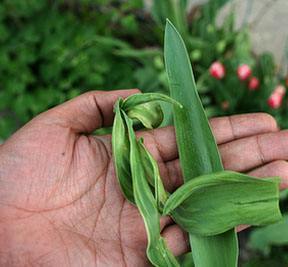
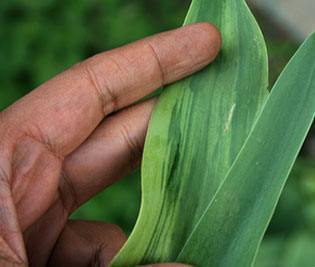
The disease is common in all areas where tulips are grown, causing the flowers to depreciate.
Symptom. The disease affects certain organs or all organs of the plant. Yellowish streaks or chlorotic spots appear on the leaves of infected plants. Due to the disease, plant growth is stunted, rooting is poor and flowering occurs 7-10 days later.
The disease also occurs on the perigone where spots, streaks or lines appear darker than normal or lighter in colour.
Transmission occurs via bulbs from infected plants and spread during vegetation is via aphids.
Prophylaxis. Preventive measures include the use of tolerant or resistant plant material, careful choice of plants used for propagation, elimination of infected plants from the crop, control of aphids that are vectors.
Recommended products
-
You can find products on a different store
Change Store -
You can find products on a different store
Change Store -
You can find products on a different store
Change Store -
You can find products on a different store
Change Store -
You can find products on a different store
Change Store -
You can find products on a different store
Change Store -
You can find products on a different store
Change Store -
You can find products on a different store
Change Store -
You can find products on a different store
Change Store -
You can find products on a different store
Change Store -
You can find products on a different store
Change Store -
You can find products on a different store
Change Store -
You can find products on a different store
Change Store -
You can find products on a different store
Change Store -
You can find products on a different store
Change Store -
You can find products on a different store
Change Store -
You can find products on a different store
Change Store -
You can find products on a different store
Change Store -
You can find products on a different store
Change Store -
You can find products on a different store
Change Store -
You can find products on a different store
Change Store -
You can find products on a different store
Change Store -
You can find products on a different store
Change Store -
You can find products on a different store
Change Store















































































































































































































































































































































































































































